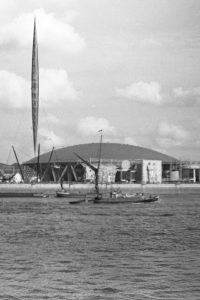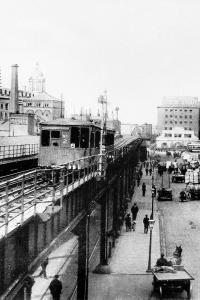The UK’s iconic landmarks are stepping into the future, courtesy of Chums, Liverpool based clothing brand. In a ground-breaking campaign, Chums has harnessed the power of artificial intelligence to breathe new life into five cherished landmarks, providing a fresh perspective on what these structures might look like in the contemporary era.
The visionary campaign seeks to address the fading prominence of these landmarks, which were once important parts of their cities’ cultures. Over time, changing preferences, evolving urban landscapes, and the march of progress have left these once-favoured landmarks overshadowed, underappreciated, or just gone.
The selected landmarks each have unique history and charm, resurrected through the lens of AI creativity. The campaign delves into the stories of these landmarks, exploring why they were once beloved and how changing times led to their decline. By leveraging AI technology, Chums aims to ignite conversations about cultural preservation and the role of innovation in revitalizing our connection to the past.
Dome of Discovery and Skylon, London


Built in 1951, the Dome of Discovery and Skylon were iconic structures on London’s South Bank during the Festival of Britain. The Dome, with its vast galleries, and Skylon, a futuristic cigar-shaped marvel, symbolised post-war optimism. Sadly, both were dismantled after only 11 months. Now, picture a reimagined South Bank – a modern curved Dome and the iconic London Eye in Skylon’s place, seamlessly blending the past with a contemporary vision for London’s skyline.
Liverpool Overhead Railway, Liverpool
Opened in 1893, the Liverpool Overhead Railway revolutionized daily commutes, shuttling workers along the docks with unparalleled speed as the world’s first electrically powered elevated railway. Affectionately known as ‘The Docker’s Umbrella,’ it shielded pedestrians from Liverpool’s elements while offering breath-taking views of the River Mersey. However, wear, tear, and bomb damage in the 1940s led to its closure in 1956. Imagine a revived Overhead Railway today – a sleek, modern platform complemented by a contemporary commuter train, seamlessly blending history with innovation and transporting passengers through the vibrant heart of Liverpool.


Trams on Queen Street, Cardiff


Introduced in 1902, Cardiff’s electric trams transformed the city’s transportation, spanning from Pier Head to Mynachdy Road and Victoria Park to Roath Depot. Despite World War I setbacks, the tram system flourished, even receiving investments for expansions and modernisation. Unfortunately, changing times and the rise of buses led to closures in 1930 and 1936. Fast forward to today, envision a revived Cardiff tramway system with a modern design, sleek appearance, and digital amenities, rekindling the golden era of public transport in the city.
Portobello Pool, Edinburgh


Opened in 1936, Portobello Pool in Edinburgh was a beloved attraction with its art deco design, high diving boards, and outdoor heated pool, attracting crowds even during torrential rain. Hosting galas and diving shows, it thrived until the 1970s when changing interests and the closure of the heating power station led to its demise in 1978. Today, imagine a revitalised Portobello Pool – an Art Deco-inspired oasis with clean lines and geometric charm, preserving the spirit of its heyday while offering a modern aquatic experience for Edinburgh residents.
Margate Jetty, Kent


Built in 1824, Margate Jetty was a beloved seaside escape, known locally as the Jarvis Landing Stage. Originally made of wood and later becoming the world’s first iron seaside pier in 1855, it was a cherished spot for ship embarkation during low tide. With its distinctive octagonal-shaped pierhead and pivotal role in the Dunkirk evacuation in 1940, the jetty was a nostalgic centrepiece of Margate. Despite facing fire damage in 1964 and eventual closure in 1976, let’s reimagine Margate Jetty today – an extended pier retaining its original charm, a timeless haven for memories by the sea.
Paul Gray, Marketing Director of Chums adds: “We hope that merging nostalgia with AI delivers a visual delight that sparks imagination. These landmarks, once the heartbeat of their communities, have lost their resonance over the years, so we thought through AI we could rekindle the flame. Envisioning a future where these landmarks could have a place in modern-day conversations, connecting generations and preserving the essence of our shared history.”
For more information and to explore the full campaign, please visit https://www.chums.co.uk/blog/the-cities-of-our-past-reimagined




